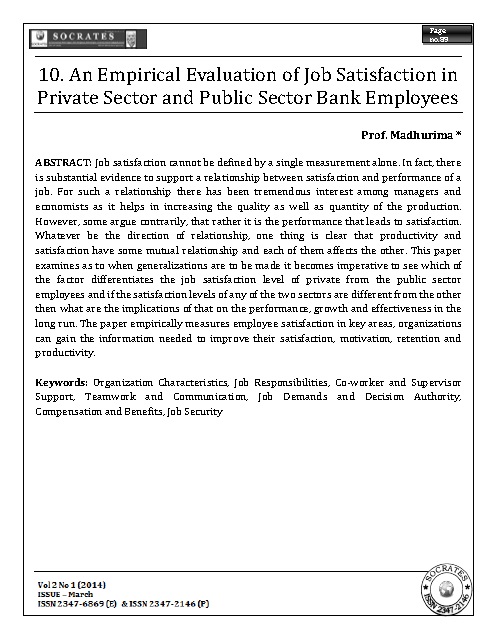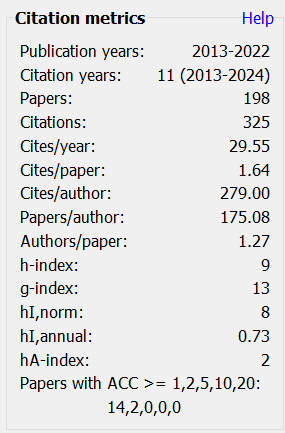An Empirical Evaluation of Job Satisfaction in Private Sector and Public Sector Bank Employees
Keywords:
Organization Characteristics, Job Responsibilities, Co-worker and Supervisor Support, Teamwork and Communication, Job Demands and Decision Authority, Compensation and Benefits, Job SecurityAbstract
Job satisfaction cannot be defined by a single measurement alone. In fact, there is substantial evidence to support a relationship between satisfaction and performance of a job. For such a relationship there has been tremendous interest among managers and economists as it helps in increasing the quality as well as quantity of the production. However, some argue contrarily, that rather it is the performance that leads to satisfaction. Whatever be the direction of relationship, one thing is clear that productivity and satisfaction have some mutual relationship and each of them affects the other. This paper examines as to when generalizations are to be made it becomes imperative to see which of the factor differentiates the job satisfaction level of private from the public sector employees and if the satisfaction levels of any of the two sectors are different from the other then what are the implications of that on the performance, growth and effectiveness in the long run. The paper empirically measures employee satisfaction in key areas, organizations can gain the information needed to improve their satisfaction, motivation, retention and productivity.
Downloads
Metrics
References
Herzberg F, Mausner B, Snyderman BB. The Motivation to Work. Transaction Publishers, Somerset, NJ, 1993.
Iaffaldano MT and Muchinsky M. "Job satisfaction and Job Performance: A Meta-Analysis", Psychological Bulletin, March 1985, pp. 251-73.
Judge TA, Thoresen CJ, Borno JE and Patton GK. "The Job Satisfaction-Job Performance Relationship: A Qualitative and Quantitative Review", Psychological Bulletin, May 2001, pp. 376-407.
http://www.shrm.org/press_published/CMS_013018.asp
Taylor, F. (1947). Scientific Management. NY: Harper & Row. (Originally published 1911).
The World Bank Group. South Asia Features, Needed: Private Investment in India's Infrastructure Creating the right environment for investors. Development News – The World Bank Daily Webzine.
lnweb18.worldbank.org/sar/sa.nsf.
Hoppock, R. (1935), Job Satisfaction. New York: Harper.
Poling, R. L. (1990). Factors associated with job satisfaction of faculty members at a landgrant university (Doctoral dissertation, The Ohio State University, 1990). Summary of Research in Extension, 5, 143.
en.wikipedia.org/wiki/Job_satisfaction
Robbins, Stephen P. Organizational Behaviour. Prentice-Hall, Inc.
Job Satisfaction: Encyclopedia of Business and Finance. http:\\www. business.enotes.com/business-finance-encyclopedia/job-satisfaction
Locke, E.A. (1976). The nature and causes of job satisfaction. In M. D. Dunnette (Ed), Handbook of industrial and organizational psychology (pp. 1297-1350). Chicago: Rand McNally.
Knowledge Leadership. Job Satisfaction. http://www.pepitone.com/content/know-humasatisfaction.asp
Sinha A.K.: "Job Satisfaction: A study of the bank employees", Indian Journal of Industrial Relations, 21: 62-65 (1985).
Berry, G. (1997). Leadership and the development of quality culture in schools. International journal of Educational Management, 11(2), 52-64.
Davis, K. and Newstorm R., Organisational Behaviour: Human Behaviour at Work, Mc Graw Hill, New York, 1985.
Arnold, H. J. & Feldman, D. C. (1982). A multivariate analysis of the determinants of job turnover. Journal of Applied Psychology, 67: 350-360.
Vroom, V.H. 1967. Work and Motivation. New York: John Wiley and Sons.
Blum, M. and J. Naylor. 1986. Industrial Psychology: Its Theoretical and Social Foundation. New York: Harper and Row.
Steven H. Applebaum, John Wunderlich, Elliot Greenstone, Danny Grenier, Barbara Shapiro,
Donald Leroux & Felix Troeger. Retention Strategies in Aerospace Turnover: A Case Study.
Career Development International. Nov. 2003, Vol. 8, Issue 6, pp. 270-282.
Kahn, Robert L.1973. "The Work Module: A Tonic for Lunchpail Lassitude", Psychology Today February, s.94.
Rousseau, Denise M. 1978. Characteristics of departments, positions, and individuals:Contexts for attitudes and behavior. Administrative Science Quarterly, Vol.15 pp. 521-540.
Rosnowski, M., & Hulin, C. (1992). The scientific merit of valid measures of general constructs with special reference to job satisfaction and job withdrawal. In C. J. Cranny, P. C. Smith, & E. F. Stone (Eds.). Job satisfaction: How people feel about their jobs and how it affects their performance. Lexington Books: New York.
Cranny. C. J., Smith, P. C., & Stone, E. F. (1992). Job satisfaction: How people feel about their jobs and how it affects their performance. Lexington Books: New York.
Judge, T. A., Hanisch, K. A., & Drankoski, R. D. (1995). Human resource management and employee attitudes. In G. R. Ferris, S. D. Rosen, & D. T. Barnum (Eds.). Handbook of human resources management. Blackwell Publishers, Ltd.: United Kingdom.
Brown, Mark G. (1996). Keeping Score: Using the Right Metrics to Drive World-Class Performance. New York: Quality Resources.
Locke, E. A. (1969). What is job satisfaction? Organizational behavior and human performance. In E. E. Lawler (1973). Motivation in work organizations. Brooks/Cole Publishing Company: Monterrey, CA
Mowday, R. T. (1992). Equity theory predictions of behavior in organizations. In R. M. Steers & L. W. Porter (Eds.). Motivation and work behavior. McGraw Hill: New York
Lawler, E. E., III (1973). Motivation in Work Organizations. Brooks/Cole Publishing Company: Monterrey, CA
Steers, R. M., & L. W. Porter (1992). Motivation and work behavior. McGraw Hill: New York.
Bowen, B. E. (1980). Job satisfaction of teacher educators in agriculture. Doctoral dissertation, The Ohio State University, Columbus
Padilla-Velez, D. (1993). Job satisfaction of vocational teachers in Puerto Rico. Doctoral dissertation, The Ohio State University, Columbus.
Moxley, L. S. (1977). Job Satisfaction of Faculty Teaching Higher Education: An Examination of Herzberg’s Dual Factor Theory and Porter’s Need Satisfaction Research. (ERIC Document Service No. ED 139 349).
Bowen, B. E. & Radhakrishna, R. B. (1991, January). Herzberg’s Motivator-Hygiene Theory and the Job Satisfaction of Agricultural Education Faculty. Paper presented at the National Agricultural Education Research Meeting, Cincinnati, OH
Castillo, J. X., Cano, J., & Conklin, E. A. (1999). Job Satisfaction of Ohio Agricultural Education Teachers. Journal of Agricultural Education 45(2), 19-27.
Brief, A. P. (1998). Attitudes in and Around Organizations. Sage: Thousand Oaks, CA
Wood, O. R. (1973). An Analysis of Faculty Motivation to Work in the North Carolina Community College System. Unpublished doctoral dissertation, North Carolina State
University, Raleigh
Smith, P. C., Kendall, L. M., & Hulin, C. L. (1969). The Measurement of Satisfaction in Work and Retirement: A Strategy for the Study of Attitudes. Rand McNally: Chicago.
Weiss, D. J., Dawis, R. V., Lofuist, L. H., & England, G. W. (1966). Instrumentation for the Theory of Work Adjustment. University of Minnesota, Minneapolis
Brayfield, A. H., & Rothe, H. F. (1951). An Index of Job Satisfaction. Journal of Applied Psychology, 35, 307-311
Scarpello, V., & Campbell, J. P. (1983). Job Satisfaction: Are All the Parts There? In A. P. Brief (1998). Attitudes in and around organizations. Sage: Thousand Oaks, CA.

Downloads
Published
How to Cite
Issue
Section
License
Revised Copyright/CC license that applies to all the articles published after 05-02-2017
Attribution-NonCommercial 4.0 International (CC BY-NC 4.0)

Copyright/CC license that applies to all the articles published before 05-02-2017
Attribution-Non Commercial-No Derivatives 4.0 International (CC BY-NC-ND 4.0)

Author(s) will retain all the right except commercial and re-publishing rights. In the case of re-publishing, they will have to obtain written permission from the journal. Additional licensing agreements (Creative Commons licenses) grants rights to readers to copy, distribute, display and perform the work as long as you give the original author(s) credit, they can not use the works for commercial purposes and are not allowed to alter, transform, or build upon the work. For any reuse or distribution, readers and users must make clear to others the license terms of this work. Any of these conditions can be waived if you get permission from the copyright holders. Nothing in this license impairs or restricts the authors’ rights. To view a copy of this license, visit http://creativecommons.org/licenses/by-nc-nd/4.0/ or send a letter to Creative Commons, 171 Second Street, Suite 300, San Francisco, California, 94105, USA.
Research Papers published in SOCRATES are licensed under an Attribution-NonCommercial-NoDerivatives 4.0 International (CC BY-NC-ND 4.0)












